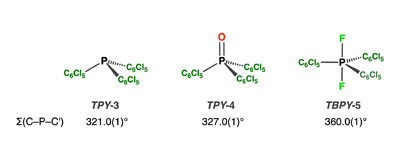|
The homoleptic phosphine with the bulky perchlorophenyl group, (C6Cl5)3P (1), exhibits trigonal pyramidal structure (TPY-3), yet considerably flattened: Σ(C-P-C') = 321.0(1)º. Key steric and electronic properties of this simple organophosphorus species have been estimated by calculation. Attending to its characteristic features, 1 can be rated as a deactivated phosphine, where the less-basic P atom is sterically shielded by the bulky C6Cl5 groups. This marked inertness notwithstanding, it has been possible to obtain (under harsh conditions) derivatives with phosphorus in high oxidation state, namely the phosphine oxide (C6Cl5)3PO (2) and the difluorophosphorane (C6Cl5)3PF2 (3). These four- and five-substituted derivatives respectively exhibit trigonal pyramidal (TPY-4) and trigonal bipyramidal (TBPY-5) structures. The Σ(C-P-C') value steadily increases along the series 1-3, according to the referred structural variation. The P-C bond length is, in turn, invariably maintained at about 185 pm regardless of the different oxidation state, the increasing number of substituents around the P atom and the overall geometry. The hypervalent difluorophosphorane (C6Cl5)3PF2 (3) dissociates one of the axial fluorides in the gas phase giving rise to the fluorophosphonium cation [(C6Cl5)3PF]+, as detected by mass spectrometry. This cation is identified as a Lewis superacid.
|

